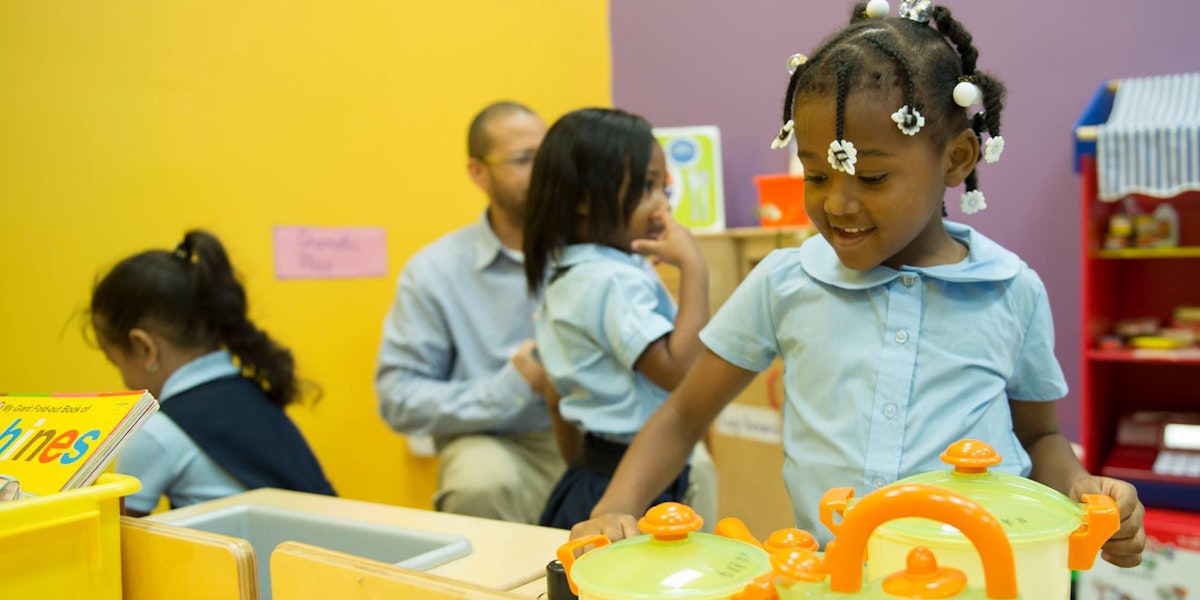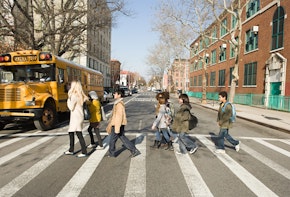New York City is the largest public school district in the United States, enrolling a socioeconomically and racially diverse student population of more than 1.1 million students in over 1,800 schools1 across five boroughs and thirty-two geographic school districts. As of 2015, citywide student demographics2 were 27.1 percent black, 15.5 percent Asian, 40.5 percent Hispanic, 14.8 percent white, and 2.1 percent identified as “other.” Nearly 77 percent of students were classified as living in poverty,3 while 12.5 percent were identified as English language learners, and 18.7 percent as students with disabilities. Although New York City as a whole contains a diverse student population, the composition of the NYC schools student body vary significantly across the city’s five boroughs. Within the Bronx, Hispanics make up the biggest proportion of students (61.7 percent), as do students living in poverty (87.9 percent). Among the five boroughs, Manhattan has the second-highest percentage of Hispanic students (45.4 percent) and the second-lowest percentage of students living in poverty (68.8 percent). Queens has the highest representation of Asian students (27.9 percent), Brooklyn has the highest proportion of black students (38.1 percent), and nearly half of Staten Island students are white (47.9 percent).4
Given the size and complexities of New York City and its public schools, resolving systemic segregation may defy any single strategy. After years of virtually no movement toward school integration, New York City officials have taken preliminary steps to make diversity a consideration in more of the district’s policies.
History of School Integration Efforts in New York City
Despite a long history of desegregation advocacy in the post-Brown v. Board era, economic and racial segregation have deepened across NYC schools in recent decades.5 A 2012 analysis highlighted extreme racial isolation in NYC schools, with more than half of schools found to have hyper-segregated black and Hispanic student enrollments of 90 percent or more, and with racial isolation of black students increasing even as residential segregation in the city was declining.6 In 2014, a report from the Civil Rights Project at UCLA identified New York City as one of the most segregated school systems in the nation.7 This research highlighted a considerable decline between 1989 and 2010 in white student enrollment rates, a significant increase in majority-minority schools from less than 50 percent of schools in 1989 to almost two-thirds of schools in 2010, a sharp 70 percent increase in racially hyper-segregated schools, and the compounding of racial and economic segregation.8 A 2016 New School report revealed that New York City elementary schools have remained segregated even as neighborhoods have diversified.9
In addition, the city’s elite specialized high schools, the most notable of which are Stuyvesant High School and the Bronx High School of Science, have disproportionately low and declining black and Hispanic admission rates. Admission to the eight specialized schools is determined by performance on the Specialized High School Admissions Test, a lengthy multiple-choice exam.10 In 2015, only 4.1 percent of specialized high school admitted students were black and 6.1 percent were Hispanic.11 In 2012, the NAACP Legal Defense and Education Fund filed a complaint with the U.S. Department of Education claiming racial bias in the specialized high school admissions process.12 Rejecting previous efforts to replace the multiple choice exam with a multiple-measures admissions model,13 state legislators and city officials offered improved test preparation to students from underrepresented middle schools and other modest initiatives to improve access to the specialized high schools in 2015.14
In recent years, a number of community advocates have raised awareness of the problem of school segregation and have pushed the New York City Department of Education to enact better policies to encourage school diversity. In October 2015, with support from NYC Councilmen Brad Lander and Ritchie Torres, grassroots activists and advocacy organizations—including IntegrateNYC4me (a Bronx-based student and teacher group), Middle School Parents for Equity, and NY Appleseed—joined with a handful of Community Education Council members and local politicians to present NYC Schools Chancellor Carmen Fariña a set of seven recommendations to desegregate NYC schools. These recommendations included formalizing a commitment to diversity, changing school admissions policies and collaborating on new enrollment systems.15
Fariña named school diversity as one of her top priorities and said she hoped to see solutions to NYC school segregation develop “organically” and not from central mandates.
Despite this mounting pressure from community organizations and local leaders, Department of Education leadership has largely resisted any commitment to the politically contentious work of systematically revamping neighborhood school zones or the admissions policies that have contributed to citywide school segregation. NYC Schools Chancellor Carmen Fariña was criticized in October 201516 for declaring, “You don’t need to have diversity within one building,” as well as promoting a pen-pal system between students attending segregated schools as a racial integration remedy.17 Several months later, Fariña named school diversity as one of her top priorities and said she hoped to see solutions to NYC school segregation develop “organically” and not from central mandates.18
Stories of School Integration
View the profiles of school districts and charter schools pursuing socio-economic integration.The Future of Brown Is Multiracial
How My Family’s Immigration Story Connects to Integration
New York City Public Schools: Small Steps in the Biggest District
Chicago Public Schools: Ensuring Diversity in Selective Enrollment and Magnet Schools
Hartford Public Schools: Striving for Equity through Interdistrict Programs
Stamford Public Schools: From Desegregated Schools to Integrated Classrooms
Dallas Independent School District: Integration as Innovation
Jefferson County Public Schools: From Legal Enforcement to Ongoing Commitment
Eden Prairie Public Schools: Adapting to Demographic Change in the Suburbs
Champaign Schools: Fighting the Opportunity Gap
The Current Plan
While systemic progress has been slow, New York City officials, lawmakers, and community leaders have begun to take some smaller steps to support school integration.
- Pilot Admissions Program. New York City Mayor Bill de Blasio and Chancellor Fariña have promoted a modest set of innovations developed by school and community leaders to support desegregation efforts, including allowing schools to pilot enrollment practices and lottery systems that reserve a specific percentage of seats for incoming students who qualify for free and reduced lunch, are classified as English language learners, or are in the child welfare system.19 This policy experiment, first extended in November 2015 to seven elementary schools whose leadership had advocated for this change, was expanded in Spring 2016 to any NYC school that wished to apply.
- Rezoning. The Department of Education also attempted to rezone a handful of elementary schools in Manhattan and Brooklyn as a solution to overcrowding and in promotion of better diversity across schools. While rezoning discussions continue in Manhattan’s District 3, the rezoning proposal for two schools in Brooklyn’s District 13 were approved in early 2016 with mixed results: P.S. 307, which currently enrolls a student body that is roughly 90 percent black and Latino and 75 percent low-income, stands to become more diverse; but nearby P.S. 8, where two-thirds of students were white or Asian and just 14 percent were low-income, will likely become more affluent and less racially diverse.20
- Controlled Choice Student Assignment Plans. In addition, in 2015, New York State awarded eight NYC high-poverty schools federal Socioeconomic Integration Pilot Program grants of $1.25 million to increase diversity and improve admissions practices.21 Relatedly, local leadership in Districts 1 and 3 in Manhattan, and District 13 in Brooklyn, have been working to design and propose new controlled-choice student-assignment plans to desegregate schools within each district.22
- Diversity Reporting. Also in 2015, city lawmakers passed the School Diversity Accountability Act, requiring the department to regularly report out demographic data and progress towards diversity at the school and district levels.23 The first report issued in December 2015 highlighted modest progress made under multiple strategies, from promoting dual-language programming to removing academic screening at middle schools to setting up homeless student support centers.24
Impact on Integration and Student Outcomes
It is too soon to gauge what impact the new pilot admissions program, and still emerging rezoning and controlled choice student assignment plans, will have on school diversity. However, early evidence indicates that some progress has been made in diversifying the incoming classes at the initial pilot schools.25 The seven pilot schools met or exceeded almost all of their admissions offer targets.26 One of those schools, The Academy of Arts and Letters in Fort Greene, Brooklyn, expected a nearly four-fold increase in the percentage of incoming kindergarten students who qualify for free and reduced lunch. The Castle Bridge School in northern Manhattan fell three points short of its ten percent target for students of incarcerated parents, though school leadership expressed confidence this shortfall would be quickly overcome.27
“I’m very pleased with the direction we’re heading in,” said Amanda Wiss, a Brooklyn District 13 resident and Arts & Letters parent. “Building our commitment to diversity, understanding not everyone is like you is really critical to becoming a respectful, caring community. It’s how kids begin to learn about each other, care about each other, it just becomes routine.”
Next Steps
In a July 2016 interview with Politico New York, Fariña expressed a willingness to address racial inequality in NYC Schools as “the elephant in the room” and pledged that diversity would be a major focus of her leadership over the coming year.28 In September 2016, Fariña said these efforts would include broader attention to school rezoning and aggressive public engagement. “I get resistance to a lot of things,” the Chancellor stated. “The idea is to have a moral compass and then go out there, and sell it, sell it and sell it.”29

This profile is part of The Century Foundation’s Stories of School Integration series.
Notes
- “About Us,” New York City Department of Education, Retrieved August, 2016, http://schools.nyc.gov/AboutUs/default.htm.
- “Data About Schools,” New York City Department of Education, http://schools.nyc.gov/AboutUs/schools/data/default.htm. (Inclusive of charter and district schools. NYCDOE 2015 demographic snapshot data, City tab.)
- “NYC DOE ‘Poverty’ counts are based on the number of students with families who have qualified for free or reduced price lunch, or are eligible for Human Resources Administration (HRA) benefits. The poverty indicator also includes students enrolled in a Universal Meal School (where all students automatically qualify). During the 2014-15 school year, all students in middle schools were eligible for free lunch. In order to better reflect free and reduced price lunch status, Universal Meal School (USM) status for middle schools (in 2014-15 and 2015-16) is based on their 2013-14 USM status.” NYCDOE 2015 demographic snapshot data, Notes tab. http://schools.nyc.gov/AboutUs/schools/data/default.htm
- “Data About Schools,” New York City Department of Education, http://schools.nyc.gov/AboutUs/schools/data/default.htm. (NYCDOE 2015 demographic snapshot data, Borough tab.)
- Y. Khan, “Demand for Integration Leads to Massive 1964 School Boycott – in New York City,” WNYC, February 3, 2016, http://www.wnyc.org/story/school-boycott-1964/.
- F. Fessenden, “A Portrait of Segregation in New York City’s schools,” New York Times, May 11, 2012, http://www.nytimes.com/interactive/2012/05/11/nyregion/segregation-in-new-york-city-public-schools.html?action=click&contentCollection=Education&module=RelatedCoverage®ion=EndOfArticle&pgtype=articl.
- J. Kucsera and G. Orfield, “New York State’s Extreme School Segregation: Inequality, Inaction and a Damaged Future,” Civil Rights Project, UCLA, 2014, https://civilrightsproject.ucla.edu/research/k-12-education/integration-and-diversity/ny-norflet-report-placeholder/Kucsera-New-York-Extreme-Segregation-2014.pdf.
- Ibid.
- C. Hemphill and N. Mader, “Segregated Schools in Integrated Neighborhoods: The City’s Schools Are Even More Divided than Our Housing,” The New School Center for New York City Affairs, http://insideschools.org/blog/item/1001049-report-schools-are-more-segregated-than-neighborhoods?tmpl=component&print=1.
- S. P. Corcoran and C. Baker-Smith, “Pathways to an Elite Education: Exploring Strategies to Diversify NYC’s Specialized High Schools,” Research Alliance for New York City Schools, 2015, http://steinhardt.nyu.edu/research_alliance/publications/pathways_to_an_elite_education.
- K. Taylor, “Legislators Seek to Promote Diversity at Elite Public High Schools,” New York Times, March 11, 2016, http://www.nytimes.com/2016/03/10/nyregion/legislators-seek-to-promote-diversity-at-specialized-schools.html.
- G. Demby, “Proposals To Diversify NYC’s Top High Schools Would Do Little To Help, Study Finds,” NPR Code Switch, April 3, 2015, http://www.npr.org/sections/codeswitch/2015/04/03/392366946/proposals-to-diversify-nycs-top-high-schools-do-little-to-help-study-finds.
- Beth Fertig, “NYC Council Pushes for More Diversity at Top Schools,” WNYC Schoolbook, 2014, www.wnyc.org/story/nyc-councilpushes-more-diversity-top-schools/.
- K. Taylor, K. (2016, March 11). “Legislators Seek to Promote Diversity at Elite Public High Schools,” New York Times, March 11, 2016, http://www.nytimes.com/2016/03/10/nyregion/legislators-seek-to-promote-diversity-at-specialized-schools.html.
- P. Wall, “Under Pressure from Advocates, City Inches Toward District-wide Integration Plan,” Chalkbeat, July 6, 2016, http://www.chalkbeat.org/posts/ny/2016/07/06/under-pressure-from-advocates-city-inches-toward-district-wide-integration-plan/#.V-LwcSgrKUk.
- A. Zimmer and N. Hurowitz, “Racial Segregation in City Schools is Just ‘Reality,’ De Blasio Says,” DnaInfo, Otctober 29, 2015, https://www.dnainfo.com/new-york/20151029/park-slope/racial-segregation-city-schools-is-just-reality-de-blasio-says.
- Ibid.
- Zimmerman, “Fariña to parents: We Need “Organic” Plans, Not Mandates, to Diversify Schools,” Chalkbeat, February 24, 2016, http://www.chalkbeat.org/posts/ny/2016/02/24/farina-to-parents-we-need-organic-plans-not-mandates-to-diversify-schools/#.V8a2ECMrK9a.
- NYC DOE press release. (11/20/2015) “Chancellor Fariña Announces New Admissions Pilot at Seven Elementary Schools Designed to Promote Diversity,” New York City Department of Education, November 20, 2015, http://schools.nyc.gov/Offices/mediarelations/NewsandSpeeches/2015-2016/Chancellor+Farina+Announces+New+Admissions+Pilot+at+Seven+Elementary+Schools+Designed+to+Promote+Div.htm
- Nikole Hannah-Jones, “Choosing a School for My Daughter in a Segregated City,” The New York Times Magazine, June 9, 2016, http://www.nytimes.com/2016/06/12/magazine/choosing-a-school-for-my-daughter-in-a-segregated-city.html?_r=0; “PS/MS 8 Robert Fulton,” InsideSchools, The Center for New York City Affairs, The New School, n.d, http://insideschools.org/component/schools/school/583; and “P.S. 307 Daniel Hale Williams,” InsideSchools, The Center for New York City Affairs, The New School, n.d, http://insideschools.org/component/schools/school/606.
- R. Ford, “Some in Manhattan Want “Controlled Choice” to Diversify Schools,”CityLimits.org, November 24, 2015, http://citylimits.org/2015/11/24/some-in-manhattan-want-controlled-choice-to-diversify-schools/.
- P. Wall, “Lower East Side Families Get First Look at a Sweeping Plan to Integrate Schools,” March 31, 2016, Chalkbeat, http://www.chalkbeat.org/posts/ny/2016/03/30/lower-east-side-families-get-first-look-at-a-district-wide-school-integration-plan/#.V8awDCMrK9Y.
- P. Wall, “City Took Steps to Boost Academic Diversity in 2015, New Report Shows. Chalkbeat, December 31, 2015, http://www.chalkbeat.org/posts/ny/2015/12/31/city-took-steps-to-boost-academic-diversity-in-2015-new-report-shows/#.V8a8wyMrK9Y.
- “Local Law 59 School Diversity Accountability Act, Report on Demographic Data in NYC Schools 12 31 2015,” New York City Department of Education, http://schools.nyc.gov/community/city/publicaffairs/KeyDocuments/default.htm.
- M. Greenberg and J. O’Reilly, J., & Quester, “It’s Not About Quotas: The Real Story Behind How Two Brooklyn Schools Have Begun to Diversify,” Chalkbeat, June 9, 2016, http://www.chalkbeat.org/posts/ny/2016/06/09/first-person-the-real-story-behind-how-two-brooklyn-schools-have-begun-to-diversify-and-why-its-not-about-quotas/#.V8afICMrK9Z.
- Y. Khan, “Seven Schools Meet Higher Diversity Goals in Fall Acceptances,” WNYC, March 15, 2016, http://www.wnyc.org/story/seven-schools-meet-higher-diversity-goals-fall-acceptances/.
- Ibid.
- E. Shapiro, “Fariña vows to focus on integration next year,” Politico NY, July 6, 2016, https://www.politicopro.com/states/new-york/city-hall/story/2016/07/farina-vows-to-focus-on-integration-next-year-103545
- B. Fertig, “City Chancellor Talks Suspensions and ‘Moral Compass’ for Promoting Diversity,” WNYC, September 6, 2016, http://www.wnyc.org/story/city-chancellor-talks-suspensions-and-moral-compass-promoting-diversity/.










